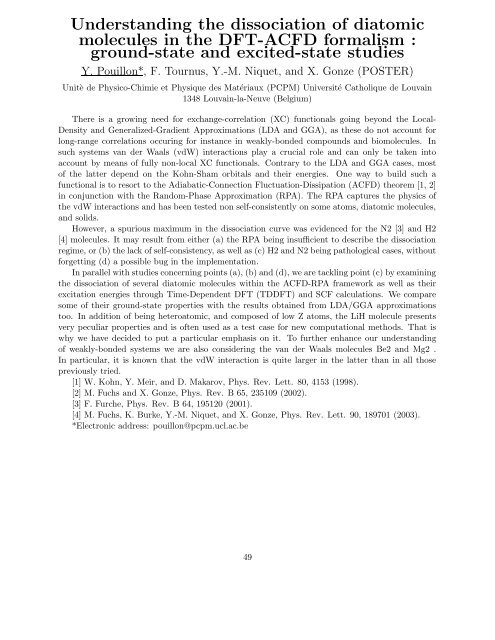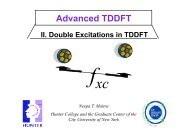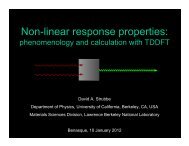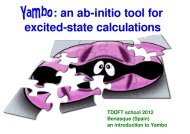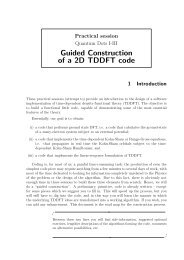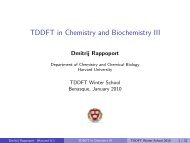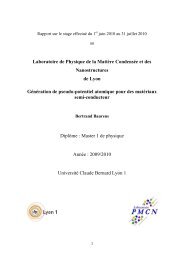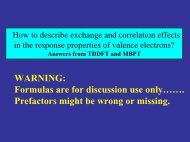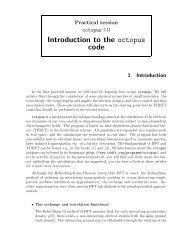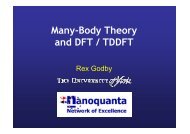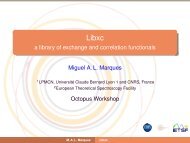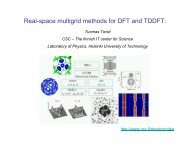TIME DEPENDENT DENSITY FUNCTIONAL THEORY ... - TDDFT.org
TIME DEPENDENT DENSITY FUNCTIONAL THEORY ... - TDDFT.org
TIME DEPENDENT DENSITY FUNCTIONAL THEORY ... - TDDFT.org
- No tags were found...
Create successful ePaper yourself
Turn your PDF publications into a flip-book with our unique Google optimized e-Paper software.
Understanding the dissociation of diatomic<br />
molecules in the DFT-ACFD formalism :<br />
ground-state and excited-state studies<br />
Y. Pouillon*, F. Tournus, Y.-M. Niquet, and X. Gonze (POSTER)<br />
Unitè de Physico-Chimie et Physique des Matériaux (PCPM) Université Catholique de Louvain<br />
1348 Louvain-la-Neuve (Belgium)<br />
There is a growing need for exchange-correlation (XC) functionals going beyond the Local-<br />
Density and Generalized-Gradient Approximations (LDA and GGA), as these do not account for<br />
long-range correlations occuring for instance in weakly-bonded compounds and biomolecules. In<br />
such systems van der Waals (vdW) interactions play a crucial role and can only be taken into<br />
account by means of fully non-local XC functionals. Contrary to the LDA and GGA cases, most<br />
of the latter depend on the Kohn-Sham orbitals and their energies. One way to build such a<br />
functional is to resort to the Adiabatic-Connection Fluctuation-Dissipation (ACFD) theorem [1, 2]<br />
in conjunction with the Random-Phase Approximation (RPA). The RPA captures the physics of<br />
the vdW interactions and has been tested non self-consistently on some atoms, diatomic molecules,<br />
and solids.<br />
However, a spurious maximum in the dissociation curve was evidenced for the N2 [3] and H2<br />
[4] molecules. It may result from either (a) the RPA being insufficient to describe the dissociation<br />
regime, or (b) the lack of self-consistency, as well as (c) H2 and N2 being pathological cases, without<br />
f<strong>org</strong>etting (d) a possible bug in the implementation.<br />
In parallel with studies concerning points (a), (b) and (d), we are tackling point (c) by examining<br />
the dissociation of several diatomic molecules within the ACFD-RPA framework as well as their<br />
excitation energies through Time-Dependent DFT (<strong>TDDFT</strong>) and SCF calculations. We compare<br />
some of their ground-state properties with the results obtained from LDA/GGA approximations<br />
too. In addition of being heteroatomic, and composed of low Z atoms, the LiH molecule presents<br />
very peculiar properties and is often used as a test case for new computational methods. That is<br />
why we have decided to put a particular emphasis on it. To further enhance our understanding<br />
of weakly-bonded systems we are also considering the van der Waals molecules Be2 and Mg2 .<br />
In particular, it is known that the vdW interaction is quite larger in the latter than in all those<br />
previously tried.<br />
[1] W. Kohn, Y. Meir, and D. Makarov, Phys. Rev. Lett. 80, 4153 (1998).<br />
[2] M. Fuchs and X. Gonze, Phys. Rev. B 65, 235109 (2002).<br />
[3] F. Furche, Phys. Rev. B 64, 195120 (2001).<br />
[4] M. Fuchs, K. Burke, Y.-M. Niquet, and X. Gonze, Phys. Rev. Lett. 90, 189701 (2003).<br />
*Electronic address: pouillon@pcpm.ucl.ac.be<br />
49


